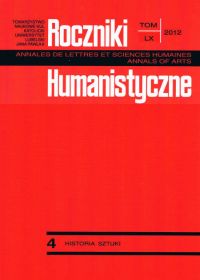Dance of Death by Mathew Merian the Elder from the Prince’s Collections of Waldburg-Wolfegg
Abstract
Dance of Death series was created in 1616 by Matthew Merian the Elder (1593-1650). His drawings were based on the fifteenth-century paintings on the cemetery wall situated next to the Dominicans' monastery in Basel, Germany. The work of the artist was very popular and was published in six different editions also numerous copies were made.
Engravings discussed in this publication were from the prince's collection at the Waldburg-Wolfegg castle. The series consists of a introduction card, two initial graphics showing the preacher and orchestra of skeletons and thirty-nine engravings depicting people with different social status, occupation and age, each paired with death personification.
Dance of Death by Merian is a unique presentation that combines the ideas of late medieval dances of death combined with modern equivalents. It concerns the equality of all people when faced with death and the traditional procession of people accompanied by personifications of death. However, lists of participants is enriched with respected people as well as critical comments which refer to specific human behavior.
The main purpose behind those graphics was to educate and propagate knowledge. Over years it has not lost its importance and is still valid today. Numerous references done by artists to this series stipulates this fact. It was also an inspiration and illustration of human life impermanence and equality of all people faced with death.
References
Biłozór Salwa M., Musicus mortalis – Musical Iconography and the Baroque Conceit, w: Polish Studies on Baroque Music, vol. 6, ed. S. Paczkowski, A.Ryszka-Komarnicka, Warszawa 2009, seria Musicology Today, s. 178-195.
Delumeau J., Grzech i strach. Poczucie winy w kulturze Zachodu XIII-XVIII wieku, przeł. A. Szymanowski, Warszawa 1994.
Demska - Trębacz M., Czas – przestrzeń – rytm. Wykłady lubelskie, Lublin 2005.
Egger F., Basler Totentanz, Basel 2009.
Frey W., „Das machet der Todten=Tanz”. Zu Tradition und Funktion der Totentänze am Beispiel des (Groß-) Basler Totentanzes, w: „Ihr müsst alle nach meiner Pfeife tanzen”. Totentänze vom 15. bis zum 20. Jahrhundert aus den Beständen der Herzog August Bibliothek Wolfenbüttel und der Bibliothek Otto Schäfer Schweinfurt, Austellungskataloge der Herzog August Bibliothek Nr. 77, oprac. zbiorowe, Wolfenbüttel 2000.
Gerber S., Die Darstellung des personifizierten Todes und ihre Rolle in der Religiösen Mentalität des Spätmittelalters und der Reformationszeit (bis etwa 1550), w: Tod und Trauer, red. T. Fischer, T. Riis, Kiel 2006, s.9-55.
Geremek B., Człowiek i zabawa: kultura ludyczna, w: Kultura Polski średniowiecznej XIV-XV w., red. B. Geremek, Warszawa 1997, s.511-532.
Huizinga J., Homo ludens. Zabawa jako źródło kultury, przeł. M. Kurecka, W. Wirpsza, Warszawa 1967.
Kobielus S., Instrumentarium Boga jako najwyższego muzyka (starożytność i średniowiecze), w: Dzieło sztuki – dzieło wiary. Przez widzialne do niewidzialnego, Ząbki 2002, s. 282-303.
Künstle K., Die Legende der drei Lebenden und der drei Toten und der Totentanz, Freiburg im Breisgau 1908.
Künstle K., Ikonographie der christlichen Kunst, Bd. I, Freiburg im Breisgau 1928.
KünstlerLangner D., Idea vanitas, jej tradycje i toposy w poezji polskiego baroku, Toruń 1993.
Mâle É., L'Art religieux de la fin du Moyen Age en France. Étude sur l'iconographie du Moyen Age et sur ses sources d'inspiration, Paris 1922.
Merian Matthäus, w: Lexikon der Kunst. Architektur, Bildende Kunst, Angewandte Kunst, Industrieformgestaltung, Kunsttheorie, red. H. Olbrich, Bd. III, Leipzig 1975, s. 276.
Merian M., Todten – Tantz, Wie derselbe in der löblichen und weitberühmten Statt Basel, Als ein Spiegel Menschlicher Beschaffenheit, gantz künstlich gemahlet zu sehen ist mit beygefügten, auss H. Schrifft und denen Alten Kirchenlehrern gezogenen, Erinnerungen, vom Tode, Aufferstehung, Jüngsten Gericht, Verdammnuss der Gott- losen, und dem Ewigen Leben, Frankfurt 1649.
Mieg M., Todten-Tantz, Wie derselbe in der Weitberühmten Statt Basel als ein Spiegel Menschlicher beschaffenheit gantz Künstlich gemahlet zu sehen ist mit Lebendigen Farben Gemahlet nicht ohne nutzliche Verwunderung zusehen ist, Basel 1621.
Piekarczyk S., Barbarzyńcy i chrześcijaństwo. Konfrontacje społecznych postaw iwzorców u Germanów, Warszawa 1968.
Piekarczyk S., W średniowiecznej rzeczywistości, Warszawa 1987.
Pirożyńska C., Łacińska rozmowa Mistrza Polikarpa ze Śmiercią. Dialogus Magistri Polycarpi cum Morte, w: Średniowiecze. Studia o kulturze, t. III, red. J. Lewański, Wrocław–Warszawa–Kraków 1966, s.75-190.
Ptaśnik J., Kultura wieków średnich. Życie religijne i społeczne, Warszawa 1959.
Purc - Stępniak B., Muzyczny koncept w nowożytnym malarstwie niderlandzkim, w: Usłyszeć obraz. Muzyka w sztuce europejskiej od XV do początku XX wieku, katalog wystawy, red. B. Purc-Stępniak, A. R. Chodyński, Gdańsk 2007,s. 114-132.
Purc - Stępniak B., W poszukiwaniu analogii między muzyką a sztukami plastycznymi, w: Usłyszeć obraz..., s. 15-44.
Sachs C., Historia instrumentów muzycznych, przeł. S. Olędzki, Kraków 1989.
Szyller E., Historia ubiorów, Warszawa 1967.
Taniec śmierci od późnego średniowiecza do końca XX wieku, katalog wystawy, red. E. Schuster, E. Ryżewska, Szczecin 2001.
Turska I., Krótki zarys historii tańca i baletu, Kraków 2009.
Włodarski M., Dwa wieki kulturalnych i literackich powiązań polsko-bazylejskich 1433-1632, Kraków 2001.
Wójcik W., Prawo cmentarne w Polsce do połowy XVI wieku, „Polonia Sacra” 10(1958), nr 2, s.165-218.
Wüthrich L. H., Matthaeus Merian d. Ä. Eine Biographie, Hamburg 2007.
Zülch W. K., Merian Matthäus d. Ä, w: Allgemeines Lexikon der Bildenden Künstler von der Antike bis zur Gegenwart, t. XXIV, red. H.Vollmer, B.C. Kreplin, L. Scheewe, H.Wolff, O. Kellner, Leipzig 1930, s.413.
Copyright (c) 2012 Roczniki Humanistyczne

This work is licensed under a Creative Commons Attribution-NonCommercial-NoDerivatives 4.0 International License.





